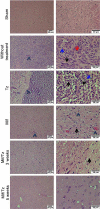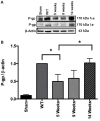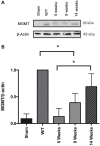Mifepristone as a Potential Therapy to Reduce Angiogenesis and P-Glycoprotein Associated With Glioblastoma Resistance to Temozolomide
- PMID: 33123485
- PMCID: PMC7571516
- DOI: 10.3389/fonc.2020.581814
Mifepristone as a Potential Therapy to Reduce Angiogenesis and P-Glycoprotein Associated With Glioblastoma Resistance to Temozolomide
Erratum in
-
Corrigendum: Mifepristone as a Potential Therapy to Reduce Angiogenesis and P-Glycoprotein Associated With Glioblastoma Resistance to Temozolomide.Front Oncol. 2021 Mar 22;11:675806. doi: 10.3389/fonc.2021.675806. eCollection 2021. Front Oncol. 2021. PMID: 33828996 Free PMC article.
Abstract
Glioblastoma, the most common primary central nervous system tumor, is characterized by extensive vascular neoformation and an area of necrosis generated by rapid proliferation. The standard treatment for this type of tumor is surgery followed by chemotherapy based on temozolomide and radiotherapy, resulting in poor patient survival. Glioblastoma is known for strong resistance to treatment, frequent recurrence and rapid progression. The aim of this study was to evaluate whether mifepristone, an antihormonal agent, can enhance the effect of temozolomide on C6 glioma cells orthotopically implanted in Wistar rats. The levels of the vascular endothelial growth factor (VEGF), and P-glycoprotein (P-gp) were examined, the former a promoter of angiogenesis that facilitates proliferation, and the latter an efflux pump transporter linked to drug resistance. After a 3-week treatment, the mifepristone/temozolomide regimen had decreased the level of VEGF and P-gp and significantly reduced tumor proliferation (detected by PET/CT images based on 18F-fluorothymidine uptake). Additionally, mifepristone proved to increase the intracerebral concentration of temozolomide. The lower level of O6-methylguanine-DNA-methyltransferase (MGMT) (related to DNA repair in tumors) previously reported for this combined treatment was herein confirmed. After the mifepristone/temozolomide treatment ended, however, the values of VEGF, P-gp, and MGMT increased and reached control levels by 14 weeks post-treatment. There was also tumor recurrence, as occurred when administering temozolomide alone. On the other hand, temozolomide led to 100% mortality within 26 days after beginning the drug treatment, while mifepristone/temozolomide enabled 70% survival 60-70 days and 30% survived over 100 days, suggesting that mifepristone could possibly act as a chemo-sensitizing agent for temozolomide.
Keywords: P-gp; angiogenesis; drug resistance; glioblastoma; mifepristone; temozolomide.
Copyright © 2020 Llaguno-Munive, León-Zetina, Vazquez-Lopez, Ramos-Godinez, Medina and Garcia-Lopez.
Figures

 ) and sham surgery (
) and sham surgery ( ); and in four groups with implanted glioma cancer cells, one without drug treatment (
); and in four groups with implanted glioma cancer cells, one without drug treatment ( ) and the other given temozolomide only (Tz) (
) and the other given temozolomide only (Tz) ( ), mifepristone only (Mif) (
), mifepristone only (Mif) ( ), and mifepristone/temozolomide (Mif/Tz) (
), and mifepristone/temozolomide (Mif/Tz) ( ). Each point of the graphic represents the mean ± SEM of six animals. *Significant difference (p < 0.05) between Mif/Tz and sham.
). Each point of the graphic represents the mean ± SEM of six animals. *Significant difference (p < 0.05) between Mif/Tz and sham.









Similar articles
-
Mifepristone Repurposing in Treatment of High-Grade Gliomas.Front Oncol. 2021 Feb 18;11:606907. doi: 10.3389/fonc.2021.606907. eCollection 2021. Front Oncol. 2021. PMID: 33680961 Free PMC article. Review.
-
Mifepristone Overcomes Tumor Resistance to Temozolomide Associated with DNA Damage Repair and Apoptosis in an Orthotopic Model of Glioblastoma.Cancers (Basel). 2018 Dec 22;11(1):16. doi: 10.3390/cancers11010016. Cancers (Basel). 2018. PMID: 30583528 Free PMC article.
-
Effect of chemotherapy-induced DNA repair on oncolytic herpes simplex viral replication.J Natl Cancer Inst. 2006 Jan 4;98(1):38-50. doi: 10.1093/jnci/djj003. J Natl Cancer Inst. 2006. PMID: 16391370
-
Glycogen synthase kinase 3β inhibition sensitizes human glioblastoma cells to temozolomide by affecting O6-methylguanine DNA methyltransferase promoter methylation via c-Myc signaling.Carcinogenesis. 2013 Oct;34(10):2206-17. doi: 10.1093/carcin/bgt182. Epub 2013 May 28. Carcinogenesis. 2013. PMID: 23715499
-
Drug Insight: temozolomide as a treatment for malignant glioma--impact of a recent trial.Nat Clin Pract Neurol. 2005 Dec;1(2):88-95. doi: 10.1038/ncpneuro0045. Nat Clin Pract Neurol. 2005. PMID: 16932504 Review.
Cited by
-
Effect of Mifepristone on Migration and Proliferation of Oral Cancer Cells.Int J Mol Sci. 2024 Aug 12;25(16):8777. doi: 10.3390/ijms25168777. Int J Mol Sci. 2024. PMID: 39201464 Free PMC article.
-
Temozolomide protects against the progression of glioblastoma via SOX4 downregulation by inhibiting the LINC00470-mediated transcription factor EGR2.CNS Neurosci Ther. 2023 Aug;29(8):2292-2307. doi: 10.1111/cns.14181. Epub 2023 Mar 29. CNS Neurosci Ther. 2023. PMID: 36987665 Free PMC article.
-
Mifepristone Repurposing in Treatment of High-Grade Gliomas.Front Oncol. 2021 Feb 18;11:606907. doi: 10.3389/fonc.2021.606907. eCollection 2021. Front Oncol. 2021. PMID: 33680961 Free PMC article. Review.
-
Obstacles to Glioblastoma Treatment Two Decades after Temozolomide.Cancers (Basel). 2022 Jun 30;14(13):3203. doi: 10.3390/cancers14133203. Cancers (Basel). 2022. PMID: 35804976 Free PMC article. Review.
-
Pharmacokinetics and bioequivalence of two formulations of mifepristone tablets in healthy Chinese subjects under fasting conditions: a single-center, open, randomized, single-dose, double-period, two-sequence, crossover trial.Front Pharmacol. 2024 Oct 16;15:1479205. doi: 10.3389/fphar.2024.1479205. eCollection 2024. Front Pharmacol. 2024. PMID: 39478967 Free PMC article.
References
-
- Llaguno-Munive M, Romero-Pina M, Serrano-Bello J, Medina LA, Uribe-Uribe N, Salazar AM, et al. Mifepristone overcomes tumor resistance to temozolomide associated with DNA damage repair and apoptosis in an orthotopic model of glioblastoma. Cancers. (2019) 11:16. 10.3390/cancers11010016 - DOI - PMC - PubMed
LinkOut - more resources
Full Text Sources
Research Materials
Miscellaneous

